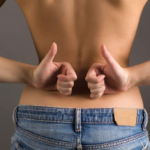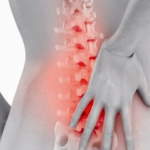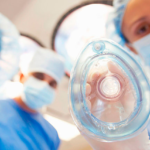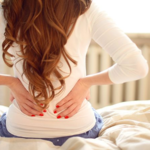Treatment of intervertebral hernia without surgery
After a thorough diagnosis, your doctor will be able to accurately determine whether a herniated disc can be treated without surgery. It is believed that surgical intervention in the development of a hernia of the spine is an extreme measure. In most cases, a combination of other methods can be dispensed with. In modern medicine, their choice is quite wide.
Medications
With an intervertebral hernia, medication treatment is carried out with one goal - to relieve pain and eliminate inflammation. To do this, they can prescribe various drugs for their action:
- non-steroidal anti-inflammatory drugs (indomethacin, diclofenac, piroxicam, etc.) relieve inflammation;
- muscle relaxants (mydocalm, sirdalud) improve blood circulation, relieve muscle spasms;
- B vitamins support the body and restore nervous tissue;
- novocaine blockade gives a quick analgesic effect and its effect lasts up to three weeks.
Pills and injections help relieve pain and significantly alleviate the patient's condition. However, remember that drugs should not be abused, all treatment should be under the strict supervision of the attending physician.
Acupuncture
Helps relieve pain and reduces inflammation. Perhaps this is one of the most controversial methods of treatment, to which many doctors are skeptical. Nevertheless, patients themselves note the effectiveness of the procedures. And if acupuncture is not considered as a separate method of treatment, but used in combination with other methods, then it can play a positive role in the recovery of the patient.
Acupuncture is used only at the initial stage of the development of an intervertebral hernia, when there is a need to relieve pain and inflammation. Here, this procedure becomes an alternative to medications.
The principle of impact on the patient's body is as follows: needles, acting on acupuncture points, relax tense muscles, release a pinched nerve and help reduce compression of the vertebrae.
The procedure time is from 15 minutes to 1.5 hours. To enhance the effect of the procedure, low power current can be supplied to the needles.
There are contraindications. Acupuncture should not be used in the following cases:
- infectious diseases;
- last trimester of pregnancy;
- heart attacks and strokes;
- tumors and metastases in the region of the spine.
And remember, this procedure should be carried out by a competent specialist. Once pain is relieved, acupuncture should be combined with other treatments.
Massage
Professional massage sessions also help to minimize pain manifestations, relax muscles, relieve tension. Massage is used in the absence of pain, it belongs to the restorative methods of treatment.
Massage can be of several types - classical, reflex, acupressure, etc. Which type is right for you, the doctor must determine, since the choice of the type of massage primarily depends on the clinical manifestations of the intervertebral hernia, the severity of symptoms and the presence of other diseases.
The duration of the massage session is also determined by the attending physician - it can vary from several minutes to an hour. During the treatment, the patient undergoes several massage courses. Most often, the duration of one course is from 20 to 30 sessions, and the break between courses is 2-3 months.
Sports
Although physical activity is limited, there are still sports that can help in the treatment of a vertebral hernia - this is swimming, cycling and skiing, walking. All these types are aimed at stretching the spine. At the same time, such types of physical activity as running, aerobics, jumping, etc. are strictly prohibited. Also, when fighting a hernia, you need to perform a number of exercises to improve posture (kinesiotherapy).
- with an intervertebral hernia in the cervical region, you need to tilt your head back and forth and right-left daily, as well as turn your head right-left. You can start with once a day for 5-6 repetitions, then you can increase the number of approaches and the number of repetitions. You can perform these exercises both sitting on a chair with a straight back, and standing.
- with an intervertebral hernia of the lumbar region, lying on the floor, stretch your arms and legs. Gently raise the sacrum area, while the legs should remain straight, and the shoulder blades should touch the floor. Hold at the top for a few seconds, tighten your buttocks. Slowly lower yourself back to the starting position. Repeat at least 10 times a day.
Lying on your back, take turns pulling your bent knees to your chin, this will help stretch your spine.
Lying and pulling both knees to the chin, roll slowly first from one side to the other, then back and forth - this will help to accelerate blood circulation and stretch the lower back.
The combination of massage and exercise aims to help the body adapt to the hernia, restore tone to weakened muscles, and relieve tension. Ultimately, this leads to the strengthening of the muscular corset and prevents the formation of new intervertebral hernias.
Physiotherapy
To relieve pain and inflammation, a course of electrophoresis . The procedure is the introduction of subcutaneous drugs using current. The most common drugs are plant enzymes papain and caripain. In the area of the intervertebral hernia, the patient is attached two electrodes with different charges, one of which is coated with a drug. During this procedure, the patient feels a slight tingling sensation. Typically, a course of 10 procedures is prescribed, each of which lasts 15 minutes. Such treatment is carried out during a period when the patient does not have acute pain. It is aimed at improving blood circulation, regenerating damaged tissues and reducing the protrusion of a hernia. There are a number of contraindications, so the treatment should be prescribed by a specialist.
The second most popular method of physiotherapy treatment is diadynamic currents . Electrodes are attached to the patient's skin in the area of localization of the intervertebral hernia, to which a direct current with low voltage is applied. The procedure is felt as a slight tingling and burning sensation. After the skin may remain red. With this method of treatment, pain is noticeably reduced, nerve endings become less sensitive, blood circulation and tissue nutrition improve. The course is 5-10 procedures, their duration is determined by the attending physician. Please note that this treatment method has serious contraindications .
Other modern methods
Laser therapy is the effect on tissues with a beam of light. In the treatment of intervertebral hernia, both red and infrared laser radiation are used, which can operate both in pulsed and continuous mode. The mode, duration and number of procedures is determined by the attending physician.
The effects of the use of laser therapy include the elimination of pain and inflammation, stimulation of blood circulation and tissue regeneration, and a positive effect on the immune system.
Laser vaporization is a non-surgical procedure performed under local anesthesia. A laser light guide is inserted through a thin needle to the leaked core of the vertebral disc and heated to a boil, thus evaporating a significant part of the liquid. The nucleus decreases in size, stops squeezing the nerve endings, and the disk returns to its place. The procedure lasts only a few minutes, while it is very effective, non-traumatic and painless. The disadvantages include the fact that laser vaporization can only be done up to 45 years old and it will not be effective on chronic hernias.
Khivamat - hardware massage of the diseased area using an electrostatic field. This method has a regenerating and analgesic effect, stimulates the production of collagen and the removal of toxins from the body, relieves inflammation and normalizes metabolism. Significantly enhances the effect of other types of treatment, if used in combination with them. The duration of the course is determined by the attending physician. The procedure has a number of contraindications. .
Cryotherapy is cold treatment. This method of treatment uses liquid nitrogen, which significantly reduces swelling and improves blood circulation. Cryotherapy is an integral part of complex therapy in the treatment of vertebral hernias. Unlike other modern physiotherapeutic methods, there are practically no complications after cryotherapy.
Manual therapy
Very often, an intervertebral hernia is accompanied by a displacement of the intervertebral joint. A chiropractor will help eliminate the displacement and restore blood circulation. However, such intervention should be as delicate as possible . Rough actions of a chiropractor can lead to new edema and worsening of the situation.
special diet
It is aimed both at reducing and normalizing the patient's weight, and at strengthening bone tissues. The emphasis in this diet is on fermented milk products with a high content of calcium, natural products - vegetables, fruits, nuts. But you will have to forget about sweets, fatty and fried foods, hot spices and bakery products for the duration of treatment. The main emphasis is on the constant supply of the body with the necessary vitamins and minerals. During periods of exacerbation, it is recommended to include fish in the diet - herring, salmon, etc. - since fish contains substances that prevent inflammatory processes.
In the treatment of an intervertebral hernia, the patient should limit physical activity - do not lift weights, do not stoop, do not make sudden movements.
Bandage
To fix the spine during the treatment period, the patient must wear a special corset or bandage, which significantly reduces the load on the spine and contributes to a speedy recovery. With an intervertebral hernia in the cervical spine, the patient must wear a special cervical collar - this device stretches the spine, gives the muscles a rest, and reduces spasm. Bandages and collars are worn during exacerbation of pain.
You do not need to use all of the above methods. Usually only a few of them are combined.
The use of one or another method in the non-surgical treatment of intervertebral hernia depends, first of all, on the patient's condition. So in the period of acute pain, only those methods are used that can alleviate the pain syndrome - drug treatment with painkillers and anti-inflammatory drugs (pills and injections), as well as physiotherapy. During this period, the patient must comply with bed rest. With the right method of therapy, pain and swelling can be removed quickly enough .
Unfortunately, most patients are guided by the principle of "no pain - no disease." But this is fundamentally wrong. After the pain syndrome is eliminated, a long treatment begins. During this period, massage and physiotherapy exercises come out among the methods. They are aimed at strengthening the muscular corset. In this case, the body itself prevents the progression of the disease. Please note that these methods complement each other, and the use of only one of them will not bring the desired results.
In addition, there are alternative methods of treatment , which are designed to alleviate the condition when a vertebral hernia appears. These include:
- Rubbing the damaged area of the back with oils (sea buckthorn or fir oil is usually recommended)
- Compresses: clay (use white and red clay), honey (honey is rubbed into the back and left overnight), alcohol (use infusions on birch buds)
- Rubbing aloe juice at the site of localization of the intervertebral hernia.
All folk methods of dealing with intervertebral hernia are mainly aimed at improving blood circulation by heating. And if this is effective enough for a hernia of the lumbar region, then it is not so easy to warm up the cervical and thoracic regions. There is another unpleasant moment when using folk remedies - the improvement in blood circulation is temporary and subsequently the edema, on the contrary, may increase in size. So do not self-medicate, and even folk methods should be used only under the supervision of a specialist. In any case, rubbing and compresses fight the symptoms, not the cause of the disease.
With a competent combination of these methods, as well as with timely treatment, surgical intervention can be avoided in more than 70% of cases. With intervertebral hernia, surgery is recommended only in cases where conservative treatment does not bring results, as well as when the patient develops neurological disorders.
And remember, the earlier you were diagnosed with an intervertebral hernia, the easier it will be to stop its development and prevent possible complications. A hernia is diagnosed with an MRI (magnetic resonance imaging). This method gives an idea of the location of the hernia, its size and the degree of compression of the spinal cord and nerve endings.
With timely treatment, in many patients the hernia decreases and does not cause problems in the future, in some the intervertebral hernia resolves completely.
Prevention of the occurrence of an intervertebral hernia
As you know, any disease is easier to prevent than to cure. A herniated disc is no exception. To minimize the risk of developing an intervertebral hernia, you must adhere to the principles of proper nutrition and try to lead an active lifestyle.
- If you have a sedentary job, you spend most of the day at a computer or driving, then you need to take a break every two to three hours and unload your muscles with a special set of exercises;
- If your work, on the contrary, is associated with lifting weights and other serious physical exertion, then the muscle corset should be as strong as possible. This can only be achieved by regular training;
- Make time for sports - go in for swimming (in the water the spine is stretched, and the load on it decreases), cycling, gymnastics. Very useful walks in the fresh air;
- It is also worth using a high-quality mattress (of medium hardness) and a pillow - if the muscles are relaxed during sleep and the tension goes away, then the likelihood of an intervertebral hernia is noticeably reduced. Pay attention to orthopedic mattresses and pillows;
- Minimize your intake of salt, sugar, and canned foods. Drink herbal teas and herbal teas. Eat foods containing vitamin C and calcium;
- Try to get rid of bad habits.
So here it is worth remembering a simple truth - a healthy lifestyle is the key to good health.
If you have already been diagnosed with an intervertebral hernia, then after the course of treatment, in order to avoid relapses, you should continue to be observed by the attending physician, perform therapeutic exercises, do not violate the diet prescribed by the doctor, do not lift weights and continue to strengthen the muscle corset.










